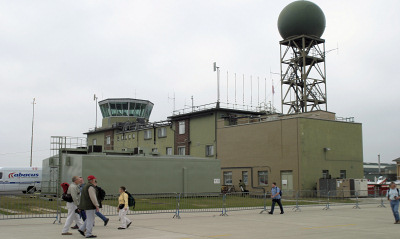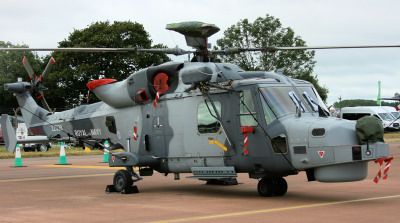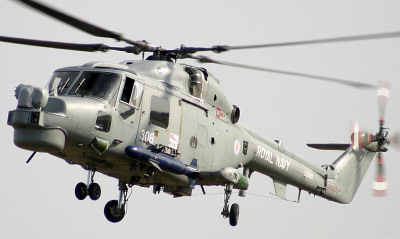Royal Naval Air Station Yeovilton (also called HMS Heron) is located north of Yeovil in Somerset, and is currently home to the Wildcat helicopters of the Royal Navy's Fleet Air Arm (FAA), Commando Helicopter Force (CHF) and Army Air Corps (AAC). The Commando Helicopter Force (CHF) Merlin helicopters are also based here.
727 NAS operate the Tutor T1 with its primary role to provide grading and legacy-Elementary Flying Training for Royal Navy and Royal Marine pilots.
Yeovilton is home to the Fleet Air Arm Museum and the Royal Navy Wildcat Demo Team.
RNAS Yeovilton Satellite View
Military Aircraft Tracker in the UK
 • Current Military Aircraft in the UK Tracker.
• Current Military Aircraft in the UK Tracker.
• Historic Military Aircraft in the UK Tracker.
• Military Aircraft around the World Tracker.
Live Trackers
When using ADS-B Exchange Tracker then click on 'U' to see military aircraft.
Scanner Frequencies
RNAS Yeovilton Scanner Frequencies
Approach - 374.950, 127.350
Radar - 374.950, 127.350
Director - 240.575, *123.300
PAR - 247.400, 397.050, *123.300
Tower - 376.300, 120.800
Ground - 362.850, *122.100
ATIS - 244.550
*= NATO Common Frequency
|
Military Aircraft Photographs at UK Military Bases
Aircraft & Squadrons
Royal Naval Air Station Yeovilton is home to all the United Kingdoms Wildcat helicopters.
The Royal Navy's Fleet Air Arm is home to the Wildcat Maritime Force's 815 NAS & 825 NAS which operate the Wildcat HMA2. Two Squadrons of the Commando Helicopter Force (Fleet Air Arm / Royal Marines) operate the Merlin helicopter (845 NAS & 846 NAS) as well as a Squadron of Wildcat helicopters (847 NAS). The British Army Joint Helicopter Command / Army Air Corps operate three Squadrons of Wildcat helicopters (652 Sqn, 659 Sqn & 661 Sqn).
727 NAS operate the Tutor T1 with its primary role to provide grading and legacy-Elementary Flying Training for Royal Navy and Royal Marine pilots under training. It also supports the Royal Navy's 'Flying Start' flying scholarship scheme.
The air station is also home to the Royal Navy School of Aircraft Control, Royal Navy School of Fighter Control, Royal Naval Reserve Air Branch, Underwater Escape Training Unit and the Royal Navy Wildcat Demo Team. British Army Royal Electrical and Mechanical Engineers 73 Aviation Company (Wildcat Support) are also based here along with the Joint Electronic Warfare Core Staff (JEWCS) as part of NATO.
Fleet Air Arm:
• 815 Naval Air Squadron - Wildcat HMA.2.
• 825 Naval Air Squadron - Wildcat HMA.2.
• 727 Naval Air Squadron - Tutor T.1.
Joint Helicopter Command/Fleet Air Arm/Royal Marines:
• 845 Naval Air Squadron CHF - Merlin HC.4/4A.
• 846 Naval Air Squadron CHF - Merlin HC.4/HC3i.
• 847 Naval Air Squadron CHF - Wildcat AH.1.
British Army (1 Regiment) JHC/AAC:
• 652 Squadron - Wildcat AH.1.
• 659 Squadron - Wildcat AH.1.
• 661 Squadron - Wildcat AH.1.
815 NAS formally retired the Lynx HMA.8 on the 23rd March 2017. See article. The Army bid farewell to the Lynx in January 2018 and more details can be found here.
History
In 1939, the Admiralty Air Division commandeered the land at Yeovilton and began construction of the site. The runways were completed in 1941 despite problems with poor drainage. 750 Naval Air Squadron (Royal Navy Observer School) moved to Yeovilton in 1939 and was joined by 751 and 752 Squadrons with the Naval Air Fighter School soon following. Westland Aircraft also developed a repair facility at the site.
From 1940, 794 Naval Air Squadron was the first to be formed at the base and served to train other squadrons to practice aerial gunnery, and part of one of the runways was marked up as a flight deck to practice landing on an aircraft carrier. 827 Naval Air Squadron was also stationed at Yeovilton operating Fairey Albacores and later Barracudas starting in May 1943.
After the War, Yeovilton became one of the main demobilization centres for the Royal Navy, with many of the men helping to refurbish the runways while they stayed at the base. In 1952, Yeovilton became the shore base for the fleets all-weather fighters. The runways were further extended in 1952 and 1957 to cope with jet aircraft. In May 1953, it became the headquarters of Flag Officer Flying Training.
During the 1960s, the School of Fighter Direction returned to Yeovilton, and the Sea Venoms were replaced by the de Havilland Sea Vixens then in turn by the McDonnell-Douglas Phantom FG.1 as a carrier-borne fighter. Royal Navy fixed wing operations were later phased out, and the Phantoms transferred to the RAF. The base remained as the home of the Commando Helicopter Squadrons, using the Wessex HU.5 and later the Sea King HC.4, and the fixed wing Fleet Requirements and Aircraft Direction Unit (FRADU) and became the main shore base for the Navy's fleet of Sea Harrier FRS.1 (and later, FA.2s). A ski-jump was installed to enable practice of ski-jump assisted take-offs.
All Harrier operations ceased in 2010 after the Strategic Defence and Security Review. The replacement Lockheed Martin F-35 Lightning II, is now due to enter service in 2018, when it will equip the Queen Elizabeth-class aircraft carriers. These aircraft will however, be operated from RAF Marham.
All 62 UK military Wildcat helicopters, which have replaced the Lynx helicopter, operate from RNAS Yeovilton.



 Wildcats.
Wildcats.

 Lynx HMA.8.
Lynx HMA.8.
 Merlin HC.3.
Merlin HC.3.
 Tutor T1.
Tutor T1.